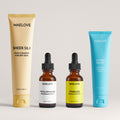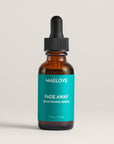
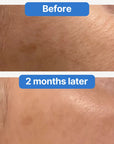
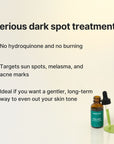

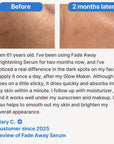


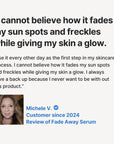
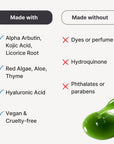
Dermatologists and customers love Fade Away because it delivers effective hyperpigmentation treatment (dark spots, melasma, acne marks, etc) without using harsh ingredients like hydroquinone.
TARGETED FADING TRIO (Alpha Arbutin, Kojic Acid, Licorice Root Extract)
- This powerhouse blend gently slows excess melanin production, targeting the same enzyme pathway that dermatologists address for stubborn dark spots.
- Unlike harsh treatments, these ingredients are suitable for consistent, daily use.
FUTURE SPOT PREVENTION (Glutathione, Red Algae)
- Helps shield your skin from free-radical and UV-induced damage, the common triggers that can cause new dark spots to form.
BOTANICAL COMPLEX Complex (Aloe, Thyme, Neem, Cucumber & more)
- Over 40 phyto-compounds from 14 botanicals work together to soothe, comfort, and support a more even-looking complexion, especially in skin that tends to react or flush.
HYDRATING BASE (Glycerin, Hyaluronic Acid, Plant Oils)
- Keeps skin feeling soft and comfortable so you can stay consistent.
- Lightweight humectants draw in water, while a whisper of plant oils helps reduce dryness without feeling greasy.
full ingredient list in FAQ
For AM and/or PM. Apply a thin layer of serum to the face, neck, and chest. Massage product in until it is fully absorbed. Follow with a gentle moisturizer to lock in the serum (AM & PM) and an SPF to block UV-damage (AM).
Start slow – use 2-3x a week, slowly ramping up to daily use and layering as tolerated.
Layer your products from thinnest to thickest in texture, waiting a full minute between each product.
Pro tip: Limit sun exposure as much as possible – UV rays darken existing spots and create new ones, often at a quicker rate than a topical skincare product like Fade Away can fade them. Since sun exposure is often unavoidable, it is best to use sunscreen daily to help minimize the sun's effect on skin and improve results.
See our How to Layer guide for tips on layering multiple Maelove products.
Customer Reviews
For the Curious
All Maelove products are safety-tested for sensitive skin, made in the US, vegan, cruelty-free, non-comedogenic, gluten-free, and free of parabens, phthalates, dyes, and artificial fragrances. We don't use ingredients that are banned in the EU or in the USA.
Aqua (Water), Butylene Glycol, Polysorbate 20, Glycerin, Alpha-Arbutin, Kojic Acid, Moringa Oleifera Seed Oil, Glycyrrhiza Glabra (Licorice) Root Extract, Sodium Hyaluronate, Cucumis Sativus (Cucumber) Fruit Extract, Rosmarinus Officinalis (Rosemary) Leaf Extract, Hamamelis Virginiana (Witch Hazel) Water, Aloe Barbadensis Leaf Juice Powder, Helianthus Annuus (Sunflower) Seed Oil, Coccinia Indica Fruit Extract, Solanum Melongena (Eggplant) Fruit Extract, Amber Powder, Thymus Vulgaris (Thyme) Flower/ Leaf Oil, Ocimum Sanctum Leaf Extract, Melia Azadirachta (Neem) Leaf Extract, Melia Azadirachta (Neem) Flower Extract, Corallina Officinalis Extract, Glutathione (L), Polyacrylate Crosspolymer-6, 1,2-Hexanediol, Caprylyl Glycol, Sodium Gluconate, Sclerotium Gum, Ethylhexylglycerin, Tropolone, Citric Acid, Sodium Hydroxide, Alcohol, Phenoxyethanol
This serum works simultaneously in two phases. The first phase is to fade existing spots with hydroquinone alternatives. The second is to help prevent hyperpigmentation with antioxidants and anti-inflammatories.
Hydroquinone is what is termed a “lightening agent” or “depigmenting agent” because it inhibits the synthesis of melanin. Melanin is the main pigment found in your skin and made by specialized skin cells called melanocytes. In hyperpigmentation, some melanocytes become overactive leading to an uneven skin tone. Hydroquinone is a tyrosinase inhibitor. Tyrosinase is the enzyme that makes melanin. Hence, by inhibiting tyrosinase function in overactive melanocytes, dark spots can start to fade over time.
Traditionally, hydroquinone has been used to treat hyperpigmentation. However, hydroquinone is considered unsafe by the cosmetic ingredient review (CIR) committee and is even banned in many parts of the world including Europe and Japan. This is because hydroquinone is toxic to melanocytes and long-term usage can lead to skin bleaching or a blue-black skin discoloration condition called exogenous ochronosis (Davis and Callender 2010). Hence, we replaced hydroquinone with the best trio of natural and safe depigmenting agents that can be used long-term. This is why we are a dermatologist favorite, as hydroquinone is not safe to use long-term.
Alpha arbutin, kojic acid, and licorice root inhibit the melanin overproduction underlying dark spots via a mechanism similar to hydroquinone - but without the safety concerns. These compounds are tyrosinase inhibitors which are non-toxic to melanocytes. Though not as potent as hydroquinone, by combining several of these weaker and safer tyrosinase inhibitors, a synergy is created that provides a safe but powerful topical to address hyperpigmentation (Boo 2021, Chandorkar et al. 2021, Hollinger et al. 2018, Woolery-Lloyd and Kammer 2011).
Arbutin is found in the leaves of the bearberry shrub or pear, cranberry, and blueberry plants, and it inhibits tyrosinase activity (Maeda and Fukuda 1996). Alpha arbutin shows specificity for mammalian tyrosinase and its effect on human tyrosinase is the greatest in its class while displaying no cytotoxicity to cells even at high concentrations (Sugimoto et al. 2004). Alpha-arbutin compared to hydroquinone is also less irritating as shown in several clinical studies confirming it safety (Chandorkar et al. 2021). Synergies increase this effectiveness and have been described with aloesin from aloe (Choi et al. 2002). Combination creams have also been tested that have equaled or exceeded the anti-melanin effects of hydroquinone. These include combinations with tranexamic acid (Boo 2021, Chandorkar et al. 2021). Aloe and tranexamic acid are included in Fade Away.
Kojic acid is an antibiotic produced by a species of fungi that is a powerful inhibitor of tyrosinase (Briganti et al. 2003). It was thought to work by chelating copper at the active site of the tyrosinase enzyme although a more recent study suggests it binds the active site of tyrosinase preventing substrates from binding (Deri et al. 2016).
Licorice root extract contain several flavonoids that inhibit tyrosinase including Glabridine, Isoliquirtin and Glabrene (Briganti et al. 2003, Chang 2009, Zhu and Gao 2008). Glabridine can prevent UVB induced pigmentation and has additional anti-inflammatory effects (Sarker et al. 2013). Finally, flavonoid Liquiritin in licorice extract improves hyperpigmentation in clinical trials though not through tyrosinase inhibition but rather through melanin dispersal and as an anti-inflammatory that can help in the treatment of melasma (Hollinger et al. 2018). Licorice extract has long been used for skin lightening in East Asian countries (Davis and Callender 2010).
Yes. We can not stress enough the need to continue use of sunscreen which is your best friend in your fight against hyperpigmentation. Sun exposure from the sun's rays darken spots at a rapid rate, quicker than the rate at which Fade Away can fade them. Sun exposure is often unavoidable and a good broad spectrum sunscreen with a minimum SPF 30 and The Glow Maker vitamin C serum will help minimize the sun's rays effect on skin. The antioxidants and anti-inflammatories in Fade Away are meant to support and not replace these powerful products.
For those with lighter skin tones, the culprit is often UV and free radical damage which accumulates with age leaving sun spots. For those with darker skin tones, the culprit behind these spots is often inflammation and in particular after skin injury from acne lesions. In some, a combination of UV and hormonal fluctuations may be the culprit in a genetic condition called melasma. For many it is a combination of two or all three of these factors (Davis and Callender 2010, Ortonne and Bissett 2008).
Fade Away serum aims to address all these causes of hyperpigmentation. As mentioned, the first step is sunscreen and a good vitamin C antioxidant serum. The additional antioxidants in Fade Away supply additional strong support. Fade Away includes anti-inflammatories to help prevent post-inflammatory hyperpigmentation.
Specifically, Fade Away contains potent antioxidant glutathione, anti-inflammatory marine red algae extract, and botanical extracts with over 40 known phytocompounds. These botanicals, long used throughout cultures for skin care, are known to contain powerful phyto-compounds that have anti-inflammatory and antioxidant properties and include ferulic acid, quercetin, zeatin, curcumin, carnosic acid, carnosol, eucalyptol, eugenol, luteolin, gallic acid, aloe-emodin, aloin, acemannan, sesamol, carvacrol, thymol, linalool, camphor, borneol, oleonolic acid, ursolic acid, rosmaric acid, azadirachtin, nimbidol, nimbolinin, nimbin, nimbidin, gedunin, salannin, beta-sitosterol, glycyrrhixin, licochalcone A, caffeic acid, chlorogenic acid, oleanolic acid, and a host of other polyphenols and flavonoids that have been scientifically shown to prevent inflammation and neutralize free radical activity. Red algae extract also contains marine compounds that have not yet been fully identified, but have been tested for their anti-inflammatory and antioxidant properties. Glutathione is a powerful antioxidant, typically produced in cells that has been shown to brighten skin.
Yes you can. However, we recommend consulting your doctor and follow their protocol.
There are some doctors who say Alpha Arbutin should not be used during pregnancy, while others will say it is fine to use. The concern over arbutin is based on studies that have shown skin bacteria and UV can lead to hydrolysis of arbutin into hydroquinone although this amount is believed to be insignificant (Boo 2021). But, due to this association with hydroquinone, some dermatologists will recommend that pregnant women do not use arbutin. At Maelove, we recommend that you first speak with your doctor about this ingredient to get their opinion. Please check out our extended writeup on how to treat hyperpigmentation while pregnant.
Both the color and the scent of Fade Away are all-natural. The botanical blend of extracts in the formula is responsible for the serum’s vibrant green color and natural scent. Many customers report the serum smells like thyme. We never use any artificial fragrances, perfumes, or dyes in our products.
Boo YC (2021). “Arbutin as a Skin Depigmenting Agent with Antimelanogenic and Antioxidant Properties.” Antioxidants 10 (1129): doi:10.3390/antiox10071129
Briganti S, Camera E, Picardo M (2003). “Chemical and Instrumental Approaches to Treat Hyperpigmentation.” Pigment Cell Res. 16: 101-110.
Chandorkar N, Amin P, Tambe S (2021). “Alpha Arbutin as a Skin Lightening Agent: A Review.” International Journal of Pharmaceutical Research. 13(2): 3502–3510
Chang TS (2009). “An Updated Review of Tyrosinase Inhibitors.” Int J Mol Sci. 10: 2440-2475. Doi: 10.3390/ijms10062440.
Davis EC, Callender VD (2010). “Post-inflammatory Hyperpigmentation: A Review of the Epidemiology, Clinical Features, and Treatment Options in Skin of Color.” The Journal of Clinical and Aesthetic Dermatology. 3(7): 20-31.
Deri B, Kanteev M, Goldfeder M, Lecina D, Guallar V, Adir N, Fishman A (2016). “The unravelling of the complex pattern of tyrosinase inhibition.” Scientific Reports 6:34993. Doi: 10.1038/srep34993.
Ebrahimi B, Naeini FF (2014). “Topical tranexamic acid as a promising treatment for melasma.” J Res Med Sci 19:753-757.
Hollinger JC, Angra K, Halder RM (2018). “Are Natural Ingredients Effective in the Management of Hyperpigmentation.” J Clin Aesthet Dermatol 11(2): 28-77.
Maeda K, Tomita Y (2007). “Mechanism of the Inhibitory Effect of Tranexamic Acid on Melanogenesis in Cultured Human Melanocytes in the Presence of Keratinocyte-conditioned Medium.” 53(4): 389-396.
Ortonne JP, Bissett DL (2008). “Latest Insights into Skin Hyperpigmentation.” Journal of Investigative Dermatology Symposium Proceedings. 13:10-14
Sugimoto K, Nishimura T, Nomura K, Sugimoto K, Kuriki T (2004). “Inhibitory Effects of a-arbutin on Melanin Synthesis in Cultured Human Melanoma Cells and a Three-Dimensional Human Skin Model.” Biol Pharm Bull 27(4): 510-514.
Woolery-Lloyd H and Kammer JN (2011). “Treatment of Hyperpigmentation.” Semin Cutan Med Surg. 30:171-175
Zhu W, Gao J (2008). “The Use of Botanical Extracts as Topical Skin-Lightening Agents for the Improvement of Skin Pigmentation Disorders.” Journal of Investigative Dermatology Symposium Proceedings 13: 20-24.
Davis EC, Callender VD (2010). “Post-inflammatory Hyperpigmentation: A Review of the Epidemiology, Clinical Features, and Treatment Options in Skin of Color.” The Journal of Clinical and Aesthetic Dermatology. 3(7): 20-31.
Ortonne JP, Bissett DL (2008). “Latest Insights into Skin Hyperpigmentation.” Journal of Investigative Dermatology Symposium Proceedings. 13:10-14
Hollinger JC, Angra K, Halder RM (2018). “Are Natural Ingredients Effective in the Management of Hyperpigmentation.” J Clin Aesthet Dermatol 11(2): 28-77.
Boo YC (2021). “Arbutin as a Skin Depigmenting Agent with Antimelanogenic and Antioxidant Properties.” Antioxidants 10 (1129): doi:10.3390/antiox10071129

This writeup was lead-authored by our senior technical adviser, Sunbin Song, PhD. Sunbin graduated from MIT with a degree in Biology before receiving a doctorate in neuroscience from Georgetown and...







